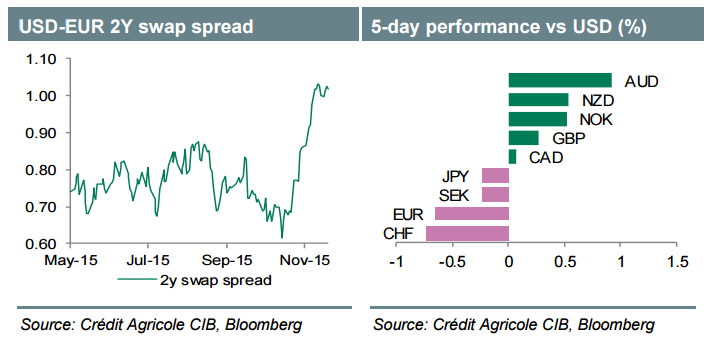USD lost ground even though the October minutes made a stronger case for a December lift-off. It appears that market expectations about the aggressiveness of the Fed tightening beyond December have become an important FX driver. Unless incoming data indicates accelerating growth momentum, the Fed should continue to signal a very cautious pace of tightening in an effort not to dampen investors’ growth and inflation expectations.
Next week’s data calendar is fairly empty with Thanksgiving likely to dampen market activity. We could see further unwinding of USD longs but doubt that investors will go cold turkey on the USD. Going into the December meeting we remain in favour of buying USD dips, in particular against JPY and NOK.
Contrary to our expectations, risk sentiment has improved even as Fed rate hike bets intensified. It appears that rising US growth expectations and the ECB’s dovish monetary policy stance have more than offset the Fed-driven tightening in US monetary conditions. However, given capped global growth expectations, commodity prices have remained under pressure. We are still bearish on commodity currencies like NOK, especially when considering that Norges Bank can ease further.
What we’re watching:
EUR – Next week’s PMI releases will unlikely have any meaningful currency impact, especially as the ECB does not seem to react to improving growth prospects for now.
GBP – Limited room of further rising rate expectations should keep GBP upside limited. Better GDP data is unlikely to change such conditions.
USD – In the absence of any top tier data releases the USD may suffer on the back of profit taking. However, USD should remain a buy on dips. Next week’s backward looking GDP will not change the firm rate expectations.
JPY – Weak inflation data may reinforce the view that the BoJ will have to ease monetary policy further in order to reach its inflation goal.
XAU – Limited room of further rising Fed rate expectations could make gold subject to upside risks.

